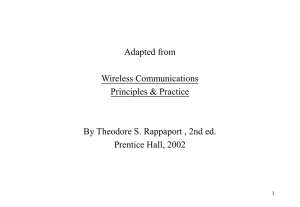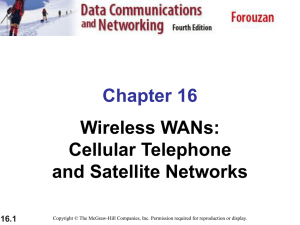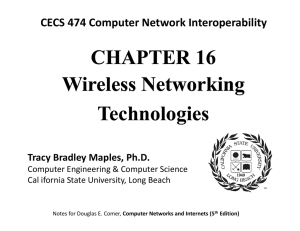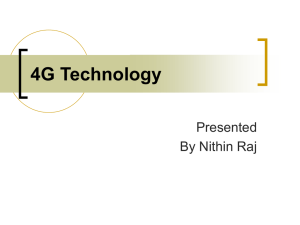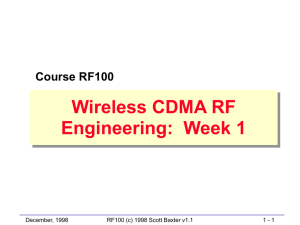Introduction to Wireless: Voice and Data
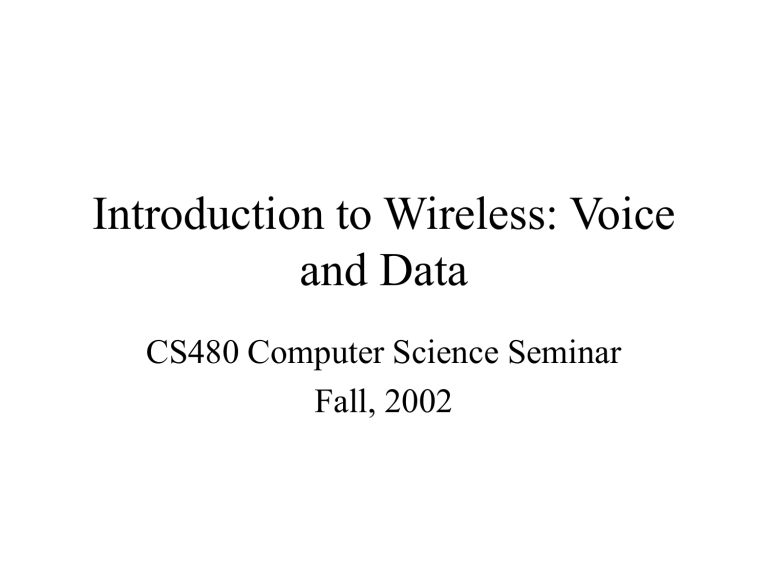
Introduction to Wireless: Voice and Data
CS480 Computer Science Seminar
Fall, 2002
Wireless Communication
• Communication without wires; invisible electromagnetic waves are used to transmit information (voice or data).
Brief History of Wireless technology
• 1876 Alexander Graham Bell demonstrated the telephone (wired).
• 1880 Bell used reflected sunlight and photoelectric selenium detector (receiver) to transmit without wire intelligible speech over 700 feet.
• Heinrich Rudolf Hertz demonstrated the existence of electromagnetic waves in the mid 19 th century.
• 1886 Guglielmo Marconi received a patent for the first practical wireless telegraph.
• 1890 Reginald Fessenden developed wireless voice communication.
• 1920 the first commercial radio station KDKA was established in Pittsburg, PA.
Brief History of Wireless technology
continued
• 1921first terrestrial mobile application, a one-way system was used at the Detroit Police Department.
• 1926 John Logie Baier demonstrated B/W television.
• 1927 color TV publicly demonstrated.
• Over the last decade, wireless industry has experienced exponential growth with cellular voice telephony accounts for the vast majority of the market. A plethora of new technologies have emerged, including Truck Mobile Radio
(TMR), paging, cordless telephony, Wireless Office Communication Systems
(WOTS), celluar, wireless LANs, Wireless Local Loop (WLL), Low Earth
Orbiting Satellites (LEOs), Personal Communication Services (PCS), Personal
Digital Assistants (PDAs). Within each technology, there exist a number of specific technologies for discussion.
Standard Organizations
• FCC, IEEE (US)
• CEPT/ETSI (Europe)
• ITU-R (international-radio communication sector).
• …etc.
• Functions include frequency allocation
(spectrum management) and power level regulation to avoid interference.
Advantages and disadvantages of wireless
• Advantages
– Reduced cost of installation
– reconfiguration, improved speed of deployment and reconfiguration
– Mobile
• Disadvantages
– Spectrum availability (radio operates between 3k to
30G Hz
– Multipath interference (MPI) leads to ghosting effect
The cell concept: frequency reuse
• Concepts date back in 1947 at Bell labs.
• Assuming 12 channels are available in a metropolitan area of 60 miles radius.
– 1 macrocell supports 12 simultaneous conversations
– Divide a macrocell into 7 microcells, a reuse factor of
128 is realized, allowing 1,536 conversations.
– Divide a macrocell into 7 picocells, the system supports in theory 6, 168 conversations.
Digital versus analog
• Advantages of digital
– More efficient use of bandwidth thru compression.
– Improved quality of transmission
– Improved security thru encryption
– Improved throughput (due to diminished error)
• Analog still in existence due to
– Incumbent technology
– Expensive and disruptive to completely rip it out
Multiplexing and access techniques:
FDMA
• Frequency division multiple access (FDMA): divides a frequency range (channel) into multiple carriers (sub channels) to support multiple conversations; guard bands are often required.
• Analog cellular systems use FDMA exclusively, e.g., U.S. AMPS (Advanced Mobile Phone
System): 40 MHz total allotted bandwidth is divided into 666 frequency pairs, each pairs has a bandwidth of 60 kHz (30 for forward channel, another 30 kHz for reverse channel).
Multiplexing and access techniques:
TDMA
• Time division multiple access (TDMA): a digital technique that divides each channel into fixed number of time slots each of which supports a conversation (similar to T-carriers).
• In GSM (Global System for Mobile
Communication), a channel of 200 kHz has a data rate of approx. 200 kbps, which is divided into 8 time slots of 25 kbps, easily supports a low-bitrate digitized voice of 9.6 kbps. Each conversation uses two time slots, one for the forward channel and one for the reverse channel.
Multiplexing and access techniques:
CDMA
• Code division multiple access (CDMA) is based on spread spectrum radio technology patented by Heddy Lamar in
1942. In spread spectrum radio, a narrow band signal is spread and sent over a much wider spectrum of radio frequencies. It may use either direct sequence (DS) or frequency hopping (FH) techniques.
• Frequency hopping spread spectrum (FHSS) is generally preferred today; it involves the transmission of short burst of packets over a range of frequency channels within the wideband carrier, with the transmitter and receiver hopping from one frequency to another in a carefully choreographed hop sequence, which is generally under the control of the centralized base station antenna .
• CDMA improves BW utilization (20:1 theoretically, around 4:1 in practice) because many users can share the same wideband radio channel.
CDMA
continued
• Qualcomm develops, manufactures, markets, and licenses CDMA products. A great number of manufacturers and providers of cellular, PCS, wireless LANs and other systems and networks have licensed CDMA.
Switched mobile radio (SMR)
• 1921 Detroit Police Department first 2-way mobile radio system (AM technology).
• Early 1930s Bayonne, NJ Police followed suit (still AM)
• Late 1930s, FM technology replaced the AM.
• 1949, FCC began to allocate spectrum and regulate it use.
• 1946 AT&T launched commercial application in St. Louis.
In addition to a 50-mile range centralized antenna, the system was connected to PSTN.
• 1960s: SMR, also known as TMR (Trunk Mobile Radio), marketed as improved mobile telephone service.
• SMR/TMR has been largely supplanted by cellular service.
Paging
• Introduced in the 1950s in New York.
• Standards
– 1981: international POCSAG (Post Office Code Standardization
Advisory Group); can support 2 millions individual addresses, tone-only, numeric, and alphanumeric pagers are supported on a one-way basis.
– ERMES (European Radio Message System): 1990, 16 European countries endorsed it.
– Motorola recently developed FLEX with the hope that it will be accepted as the new international standard. It supports
• 5 billion addresses
• FLEX: 1600 bps, 25 kHz channel, one-way
• ReFLEX: 1600, 3200, 6400, and 9600 bps, 25 or 50 kHz channels downstream and 12.5 kHz upstream, two-way.
• InFLEX: up to 112 kbps, 50 kHz channels in the narrowband
PCS range; two-way, supported compressed voice downstream
Paging equipment and applications: contemporary and developing
• Opportunities for innovators to come up with new applications.
Cordless telephone and wireless office telecommunication systems (WOTS)
Cellular Radio
• Concepts date back in 1947 at Bell labs to meet the increasing demand of SMR/TMR radio systems.
• Highly scalable: cell size can be flexibly changed.
• Cell diameter usually ranges from 1 to 5 miles, depending on topography.
• Can switch from one cell to another thru hand-off, which is handled by MTSO (mobile traffic switching office).
MTSOs are interconnected and are connected to PTSN.
• Soft hand-off (make and break) or hard hand-off (bread and make); both are fine with voice communication, but the latter has problem with data communication.
Cellular standards
• Analog cellular: G1 cellular systems
– AMPS: AT&T and Motorola; rapidly giving way to digital technology worldwide.
– N-AMPS: narrow-band AMPS; Motorola.
– NMT (Nordic mobile telephone) in scandinavia
– TACS (Total access communication system) developed in England.
Cellular standards
continued
• Digital cellular: G2 cellular systems
– GSM (Global System for Mobile communication): dominates worldwide; adopted in 1987 for pan-Europe systems; operates in the 800 and 900 MHz ranges and is ISDN compatible; 4-cell reuse plan and each cell is divided into 12 sectors; used CDMA; supporting roaming from country to country.
– D-AMPS (Digital AMPS): AKA US TDMA is the N.
Am. Standard; operates in the same 800 MHz band as
AMPS and uses the same 30 kHz bands as AMPS;
3:1improvement on band utilization over AMPS; coexists with AMPS; data rate up to 28.8 bps.
• Others: PDC (Japanese Digital Cellular), PCS
(Personal digital system).
The future of cellular radio: G3?
• Market increases quickly over the years worldwide, often beyond projection.
• Cost continues to drop: $.45/minute in the early 90s to 9.4 cents in 2000.
• G3 proposals are under consideration
– Calls for data rate from 144 kbps (fast moving) to 384 kbps (pedestrian).
– Supports global roaming
Wireless data networks: packet radio
• Operating at various data rates (4.8 - 19.6 kbps; 77 kbps) and and bands (e.g., 800-900 MHz, 902-928
MHz, 2.3 and 2.4 GHz) from different companies
(BellSouth, Ardis, Metricom, etc.) data-specific wireless networks have been deployed all over the metropolitan areas in the US over the last few years.
• Properiety packet protocols are used.
Wireless LANs or WLANs
• Based largely on spread-sprectrum technology.
• Operate in IR, radio range (e.g., 2.4-2.4834 GHz).
• Raw bandwidth 4 MHz with effective throughput around 2 Mbps per hub. Infrared-based bridges run at speed up to 622 Mbps.
• Standards were finalized in 1997 by IEEE (802-
11)
• Moderate success over the last few years.
Wireless local loop (WLL)
• Local loops were owned by ILECs (incumbent local exchange carriers). The Telecommunication
Act of 1996 opened the local loops for competition.
• Options:
– twisted pair (old and slow); not the way to go
– fiber: optimum choice, but too expensive now for low capacity application (needs killer applications).
– So, Wireless local loops is a good choice. But it radio frequency and other electromagnetc inteference can be a problem.
